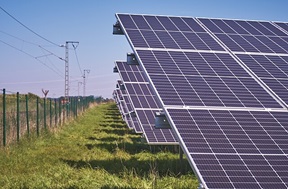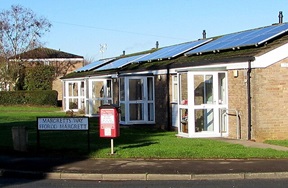Solar energy continues to astonish the world. In 2024, new developments will ensure continued growth; both in generation and in storage.

Largest source of electricity generation
Present developments indicate that in 2025, renewables will become the largest source of electricity generation. And they will continue to grow. In 2028, renewable sources will account for over 42% of global electricity generation. China will lead the world, and account for almost 60% of new renewable capacity. One area of revolutionary developments is energy storage. With lithium-ion and flow batteries, specifically designed for storage of solar energy.
Solar energy leads the development. Production company Tamesol lists the following features.
- Increased efficiency of solar panels. Solar panels get more efficient all the time. Materials and design advances in solar energy enable panels to convert more sunlight into electricity, making solar installations more practical and cost-effective for a broader range of applications.
- Expansion of bifacial solar panels. Bifacial solar panels, which capture sunlight from both sides, are becoming more popular. This significantly boosts energy production.
- Rise of building-integrated photovoltaics (BIPV). BIPV integrates solar technology into building materials like roofing and windows. This is aesthetically more rewarding and expands the application of solar energy in urban environments.
- Growth in solar energy storage solutions. The advancement in energy storage technologies, such as lithium-ion and solid-state batteries, is a crucial trend. These solutions make solar power more reliable, even during non-sunny periods.
- Proliferation of smart solar systems. The integration of smart technology with solar systems is gaining traction. IoT and AI are being used for real-time monitoring and optimization of energy production, enhancing the efficiency and effectiveness of solar power systems.

Better technologies
To this, the site adds advancements in solar technology. Like the development of perovskite solar cells (cheaper and more efficient). And of transparent solar cells, that can be integrated into windows. The advance of floating solar farms, that can produce electricity from panels floating on water, while being cooled at the same time. And of solar skins – an innovative technology that allows solar panels to have customizable appearances, particularly useful on buildings. And last but not least, the advent of AI-optimized energy systems. These can predict energy consumption and production, enabling smarter energy management.
Energy management
Of these technologies, energy storage will attract special attention. Solar energy is by nature intermittent; not just between day and night but also across the seasons. The electric grid is going to need a mix of storage solutions, depending on load profile characteristics. Storage technologies will have to be able to mimic a ‘baseload’ situation. And indeed, there are technologies that together hold such a promise. This will include lithium-ion batteries to provide short-term storage. Also mid-term storage, like iron-air or zinc-based batteries. In addition, the system is going to need some very long-duration – even seasonal – energy storage, that can pitch in for months at a time; like hydrogen-based and even gravity-based storage. Moreover, energy management systems are in development that will even empower households to optimise their solar energy usage and reduce reliance on grid power.
And solar power doesn’t need any more to be centralized, distributed by a utility. Decentralization is becoming a key theme in the solar energy sector. Technologically, there are advancements in microgrid technology; economically, there is the advent of peer-to-peer energy trading platforms. With them, individuals and communities can take more control over their energy production and consumption. They can build a microgrid. Decentralized solar power systems empower users. They can now generate, store, and trade energy locally; that will support their energy independence and resilience.
The role of policy
Government policies will play an important role here; they increasingly recognize the importance of solar energy. They can announce incentives like tax credits, feed-in tariffs, and favourable regulations. They can set renewable energy targets. They can take measures that support investments in solar projects, thereby creating an environment for industry growth. All in all, the future of solar energy looks promising. It is on the track towards widespread adoption, with technological innovations, increased storage capabilities, decentralized systems, and supportive policies.
As the price of solar energy keeps on falling, it will continue to grow. New technologies are being developed and applied all the time. Like the use of nanomaterials to increase the efficiency of solar cells; the development of transparent solar panels that can be integrated into windows and other building materials; and the use of artificial intelligence to optimize the performance of solar systems.
Falling prices
And solar doesn’t just grow in the domestic sector. It is also expected to play an increasingly important role in the transportation sector. Solar panels can and will be used to power electric vehicles.
This entire process of solar energy securing a foothold in our energy system has been driven by consistently falling prices. This development doesn’t slow down. Therefore we can expect better financing options to become available, and more installers to specialize in solar energy. For both residential and commercial consumers, solar panels will become more accessible. In the same process, maintenance costs will come down – certainly when viewed across their life span.
Policy
Governments will implement policies that encourage growth. Including energy target setting and innovative schemes that promote solar energy amongst homeowners and businesses. Aided by the widespread adoption of feed-in tariffs.
As solar projects develop, more attention will be given to community solar projects. In such a project, members of a community partner together to invest in, and develop shared solar installations. In doing so, ever more people will have access to cheap solar energy. This will be accompanied by schemes that pay upfront for the panels, thereby further democratizing access to this form of power generation.
The solar energy revolution
Driven by a continuous flow of technological innovations, solar energy has now gained a strong foothold in our energy landscape. It will reduce our dependence on fossil fuels. It provides efficient, environmentally friendly, and affordable renewable energy. We are in the middle of a solar energy revolution.
Interesting? Then also read:
Energy forecasts
Energy storage will accelerate the transition
A common sense or 50-50-40 energy scenario. Part 2: renewable energy
